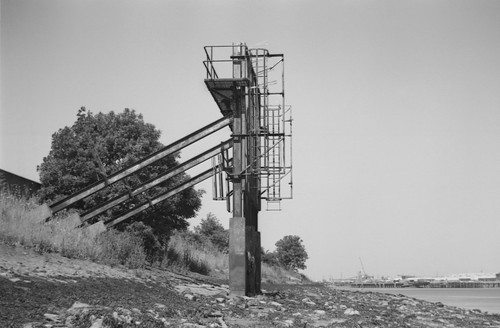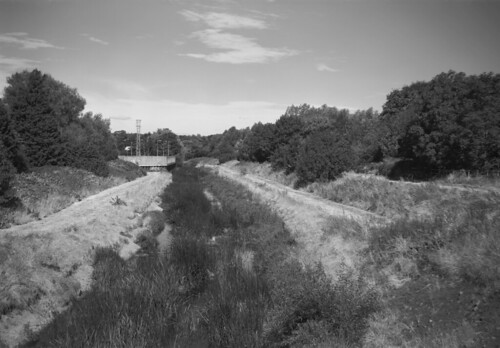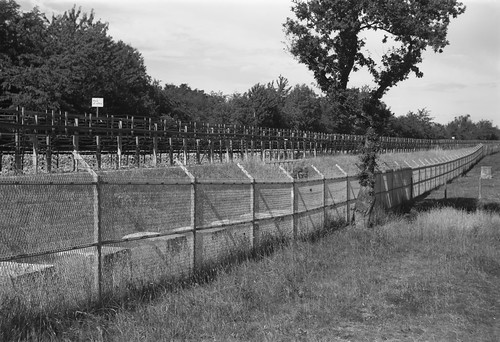 |
| Kodak Technical Pan in 35mm & 120 medium format |
It was announced in 2003 that
Kodak Technical Pan (or simply 'Tech Pan') had been discontinued. The announcement confirmed that the film had not been manufactured for some time and Kodak had been simply selling their existing stock: "The last Tech Pan coating was several years ago. Since that time, the old coating room has been shut down, the gels used in the product formulation have become obsolete, and we no longer manufacture the ESTAR support on which the 35 mm product was coated."
The
information leaflet that comes inside the film box states:
This is a black-and-white panchromatic film with extended red sensitivity.
It has micro-fine or extremely fine grain (depending on the developer
used), extremely high resolving power, and a wide contrast range for pictorial, scientific, technical, and reversal-processing applications.
Kodak's
technical data sheet P-255 lists the range of applications as:
- Pictorial photography
- Photomicrography
- Microphotography (Microfilming)
- Solar photography
- Photographing electrophoteric gels
- Laser recording
- Other applications such as slidemaking, copying, and microfilming that require high or moderately high contrast combined with fine grain and high resolving power
 |
| 35mm Technical Pan with information leaflet |
The leaflet gives a suggestion of exposure index settings and specific contrast indexes, from 16 to 200. For 'pictorial applications' it suggests an EI of 25 and development with Technidol. Having picked up a handful of rolls of Tech Pan from online auctions, on one of the sunniest days of the summer, I shot a roll of 35mm Tech Pan in my
Werra camera, exposed at 25 EI. The bright conditions were needed to shoot hand-held with a low exposure index (using the 'sunny 16' rule at 25 EI, bright sunshine would indicate an exposure of 1/25th at f16, although I would tend to give bright sunshine in the UK one stop more exposure, which in practice meant shooting at 1/50th at f8 or 1/100th at f5.6).
The
Massive Dev Chart has a section on
discontinued film which includes
Tech Pan. I developed the film in Rodinal 1:150 for 13 minutes at 20ºC, much longer than the recommended 7 minutes from the Massive Dev Chart. The results do appear overdeveloped, but a dilution of 1:150 for Rodinal seemed very low and the film was 16 years past its 'process before' date. However, judging by the results, the age of the film does not appear to have needed compensating for in development. At these high dilutions of Rodinal, consideration must be given to the capacity of the developing tank: Agfa, Rodinal's original manufacturer, recommended a minimum of 10ml per film, no matter the dilution used, which at 1:150 would mean a litre and a half of working solution. In practice a smaller amount of Rodinal works perfectly well; I used 6ml of developer to 900ml of water in a 3-reel Paterson tank.
 |
| The Banks of the Thames near Erith, Kodak Tech Pan (35mm), rated EI 25. Developed in Rodinal 1:150, 13mins at 20ºC. |
In the scanned negatives, grain is not discernible. Presumably the grain is beyond the limit of the optical resolution of the flatbed scanners I've used. There is what looks like grain in the sky of some shots, but it appears to be noise introduced by the scanner. Having shot the photographs in bright sunlight, the images were always going to be high in contrast, regardless of the qualities of the film used. However, the blue skies reproduced darker in tone than might be expected with heightened contrast. In the section about pictorial photography in the data sheet, it states that "the extended red sensitivity has a haze-cutting effect in photographs
of distant landscapes and in aerial shots." As well as cutting haze, this extended red sensitivity presumably compensates for the usual over-sensitivity to the blue end of the spectrum that normal panchromatic film has.
 |
Concrete Defences near Thamesmead, Kodak Tech Pan (35mm), rated EI 25.
Developed in Rodinal 1:150, 13mins
at 20ºC. |
I subsequently shot a roll of Tech Pan in medium format using my
Baldalux camera, exposed at 25 EI and developed in Rodinal at 1:150 again, but for 12 minutes at 18ºC (roughly equivalent to 10 minutes at 20ºC; this film had a 'process before' date of 02/1995).
 |
Roding Lane South Pumping Station, Kodak Tech Pan (medium format) rated 25 EI.
Developed in Rodinal, 1:150, 12mins at 18ºC. |
The contrast of the images is still there, perhaps a higher dilution
of developer would provide lower contrast (the Massive Dev Chart does list times for dilutions of 1:300 for Rodinal). Interestingly, the absence of discernible grain in the sky proved a problem in scanning and processing some of the negatives. In the photograph of the River Roding below, there is some banding in the image, noticeable in towards the top corners partly due to vignetting; attempts to reduce the vignetting using Photoshop's lens correction filter made the banding worse. The solution to banding in smooth tonal gradations in a digital image is to
introduce noise, which I haven't done.
 |
River Roding, Kodak Tech Pan (medium format), rated EI 25.
Developed in Rodinal 1:150, 12mins at 18ºC. |
 |
Gants Hill Telephone Exchange, Kodak Tech Pan (medium format), rated EI 25.
Developed
in Rodinal 1:150, 12mins at 18ºC. |
 |
London Defensive Ring, Kodak Tech Pan (medium format) rated EI 25.
Developed in Rodinal, 1:150, 12mins at 18ºC. |
 |
Newbury Park Tank Traps, Kodak Tech Pan film (medium format) rated 25 EI.
Developed in Rodinal, 1:150, 12mins at 18ºC. |
Notes/Sources
Technical Pan
data sheet P-255 (PDF file)
http://en.wikipedia.org/wiki/Technical_Pan
http://unblinkingeye.com/Articles/Times/TechPan/techpan.html
The nearest equivalent in terms of Tech Pan's characteristics currently in production is Rollei ATP









Really nice writeup of this very interesting film. I looked at a couple of your photos at full size over on Flickr and was astonished by the lack of apparent grain.
ReplyDeleteThanks. I'm pleased enough with the results to want to get hold of more Tech Pan for the sort of landscape/architectural shots I do.
DeleteI've recently purchased a stock of 12 rolls of Tech Pan expired in 1999. The guy at my local shop also has one remaining can of Technidol, which I still haven't purchased in consideration of the fact that I still haven't organized a project involving Tech Pan as my medium. Anyway, the feeling is like having 12 bottles of precious aged wine waiting to be opened for a special occasion.
ReplyDeleteI can identify with that feeling. I've got just the one roll of Tech Pan in the fridge at the moment, waiting for the right project to use it on.
DeleteI developed the film in POTA. I had to rate the film at 50ASA to get enough contrast. I have five cassettes of the film & I cant seem to find any Anhydrous Sodium Sulphite, one of the ingredients of POTA.
ReplyDeletePOTA is 5gm Phenidone and 50gm Anh Sod Sulphite & water to make 1L. For 50 ASA 6 1/2 min at 20C.
You mix the developer and use it immediately. Therefore I used to have four films to develope in two tanks & do them at the same time.
I'm shooting a roll now and will be using you recommendations for development. I did find that a few things on the NET: one is to not use a stopbath but Kodak recommended using so I will and second Kodak recommends an unusual type of agitation. Did you use Kodaks or another type? Thanks for the write-up.
ReplyDeleteThanks for your comment. I'm pretty sure when I developed my Tech Pan I used water (two changes with agitation) in place of a stop bath; as to agitation it was probably 30s to start and then a gentle 10 seconds each minute. Fix was Ilford Hypam.
DeleteThis comment has been removed by the author.
DeleteThanks, I did use a stop bath very dilute and I used an agitation scheme close to yours. Mine came out good especially for the first time. I have two more rolls to go through. If you are interested go to Flickr and find carter3john then search my site for TechnicalPan.
Delete